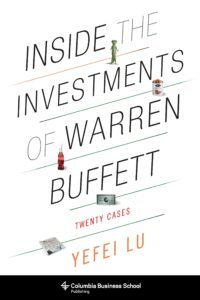Investments are subject to risk. All investments. And they are more or less dependent on how well the investor understands the opportunity. Doesn’t matter if you invest in business, stock markets, or real estate, they key is to understand what factors influence the performance of the investment and the ability to gather information related to those influencing factors.
Most professional investors know what these factors are and many have access to the information. In spite of this similarity among investors, some perform well, while others perish. Then, what is it that separates the successful investors from the lot. Strategy. Some people trade in penny stocks while others bet only on star performers. Some bet on the Luxury housing segment while others focus on volume in the affordable housing market. It is often the strategy and nimbleness of the investor that makes one better than the other.
In Inside the investments of Warren Buffet, Yefei Lu tries to identify this X factor. The author goes beyond the published technical factors and evaluates the larger business and social environment as well as other hidden factors that may have helped Warren Buffet make stellar investments.
Yefei Lu is a portfolio manager at Shareholder Value Management AG, a value-investment company based in Frankfurt, Germany. He holds an MBA from the London Business School and a Bachelor of Science in Economics from Stanford University.
 Inside the Investments of Warren Buffett: Twenty Cases
Inside the Investments of Warren Buffett: Twenty Cases
Author: Yefei Lu
Series: Columbia Business School Publishing
Hardcover: 312 pages
Publisher: Columbia University Press (August 2, 2016)
ISBN-10: 0231164629, 978-0231164627
The author aims to trace the path that Warren Buffet took over the last few decades and look at the investments he made. The book focuses on twenty investments at different stages of Warren Buffet’s career. The book is much more that a laundry list of lessons learnt or a list of investment principles.
Lu looks at each investment in great detail and establishes the broader context in which each investment was made. He meticulously details the history of each company, its past performance, its situation at the time Warren Buffet chose to invest in the company and the result. For example, while the Salad Oil scandal of American Express – when the stock dropped nearly fifty percent – the valuation was still too high according to Warren Buffet’s usual standards. Lu shows the reader how and why Warren Buffet must have spotted a structural advantage in the way American Express operated, and decided to invest at a higher price.
Throughout the book the author quotes specific financial information from the invested companies’ financial reports and other publicly published documents. He then pieces together the puzzle pieces by looking at this information and what Warren Buffet had communicated to his partnership to arrive at a reasonable solution to the puzzle.
Inside the Investments of Warren Buffet is an excellent resource to students of finance, specifically those who are interested in the field of investments and portfolio management. For other readers, the technical details and financial terms can prove a bit difficult to understand – unless they are ready to dig further into each.